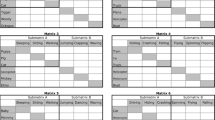Abstract
Foss (Journal of Experimental Psychology, 76, 450–459, 1968a; Journal of Experimental Psychology, 77, 341–344, 1968b) compared overlap and non-overlap instruction to promote recombinative response generalization using a matrix training procedure. In the present study, we used a similar set of procedures to teach tacting of kitchen items and prepositions (i.e., relational autoclitics) to three females ages 13–20, diagnosed with autism spectrum disorder. We taught some kitchen items/prepositions as tacts (e.g., “the strainer is to the right of the box”) according to a non-overlap instructional sequence. Subsequently, we taught more combinations in an overlap instructional sequence. Each training procedure was followed by probes of untrained relations. Two participants demonstrated recombinative generalization of untrained combinations following the first non-overlap phase, while the third participant demonstrated some response generalization of untrained relations after a few additional training sequences. All three participants demonstrated generalized tacting of object components while two participants showed generalized tacting of preposition components.



Similar content being viewed by others
Notes
Additional results from this study regarding cross-modal transfer were not included due to limited baseline (Allie and Jessie) and probe data (Jessie). Results indicated transfer across modalities to listener responses for Gale and Allie when experimenters trained only tacting for Allie and Gale. Jessie demonstrated response generalization of listener responses for most components and for trained and untrained combinations. For more information, address correspondence to the authors.
References
Alessi, G. (1987). Generative strategies and teaching for generalization. The Analysis of Verbal Behavior, 5, 15–27.
Axe, J. B., & Sainato, D. M. (2010). Matrix training of preliteracy skills with preschoolers with autism. Journal of Applied Behavior Analysis, 43, 635–652. doi:10.1901/jaba.2010.43-635.
Baer, D. M. (1981). How to plan for generalization. Lawrence: H & H Enterprises, Inc.
Dauphin, M., Kinney, E. M., & Stromer, R. (2004). Using video-enhanced activity schedules and matrix training to teach sociodramatic play to a child with autism. Journal of Positive Behavior Interventions, 6, 238–250. doi:10.1177/10983007040060040501.
Fisher, W., Piazza, C., Bowman, L., Hagopian, L., Owens, J., & Slevin, I. (1992). A comparison of two approaches for identifying reinforcers for persons with severe and profound disabilities. Journal of Applied Behavior Analysis, 25, 491–498. doi:10.1901/jaba.1992.25-491.
Foss, D. J. (1968a). An analysis of learning in a miniature linguistic system. Journal of Experimental Psychology, 76, 450–459. doi:10.1037/h0025506.
Foss, D. J. (1968b). Learning and discovery of the acquisition of structured material effects of number of items and their sequence. Journal of Experimental Psychology, 77, 341–344. doi:10.1037/h0025758.
Goldstein, H. (1983). Recombinative generalization: relationships between environmental conditions and the linguistic repertoires of language learners. Analysis and Intervention in Developmental Disabilities, 3, 279–293. doi:10.1016/0270-4684(83)90002-2.
Goldstein, H., & Brown, W. H. (1989). Observational learning of receptive and expressive language by handicapped preschool children. Education and Treatment of Children, 12, 5–37.
Goldstein, H., & Mousetis, L. (1989). Generalized language learning by children with severe mental retardation: effects of peers’ expressive modeling. Journal of Applied Behavior Analysis, 22, 245–259. doi:10.1901/jaba.1989.22-245.
Goldstein, H., Angelo, D., & Mousetis, L. (1987). Acquisition and extension of syntactic repertoires by severely mentally retarded youth. Research in Developmental Disabilities, 8, 549–574. doi:10.1016/0891-4222(87)90054-0.
Karlan, G. R., Brenn-White, B., Lentz, A., Hodur, P., Egger, D., & Frankoff, D. (1982). Establishing generalized, productive verb-noun phrase usage in a manual language system with moderately handicapped children. The Journal of Speech and Hearing Disorders, 47, 31–42. doi:10.1044/jshd.4701.31.
Kinney, E. M., Vedora, J., & Stromer, R. (2003). Computer-presented video models to teach generative spelling to a child with autism spectrum disorder. Journal of Positive Behavior Interventions, 5, 22–29. doi:10.1177/10983007030050010301.
Light, P., Watson, J., & Remington, B. (1990). Beyond the single sign: the significance of sign order in a matrix-based approach to teaching productive sign combinations. Mental Handicap Research, 3, 161–178. doi:10.1111/j.1468-3148.1990.tb00034.x.
Remington, B., Watson, J., & Light, P. (1990). Beyond the single sign: a matrix-based approach to teaching productive sign combinations. Mental Handicap Research, 3, 33–50. doi:10.1111/j.1468-3148.1990.tb00079.x.
Stokes, T. F., & Baer, D. M. (1977). An implicit technology of generalization. Journal of Applied Behavior Analysis, 10, 349–367. doi:10.1901/jaba.1977.10-349.
Striefel, S., & Wetherby, B. (1973). Instruction-following behavior of a retarded child and its controlling stimuli. Journal of Applied Behavior Analysis, 6, 663–670. doi:10.1901/jaba.1973.6-663.
Striefel, S., Wetherby, B., & Karlan, G. (1976). Establishing generalized verb-noun instruction-following skills in retarded children. Journal of Experimental Child Psychology, 22, 247–260. doi:10.1016/0022-0965(76)90005-9.
Striefel, S., Wetherby, B., & Karlan, G. R. (1978). Developing generalized instruction-following behavior in severely retarded people. In C. E. Meyers (Ed.), Quality of life in severely and profoundly mentally retarded people: research foundations for improvement (pp. 267–326). Washington, DC: American Association on Mental Deficiency.
Tanji, T., & Noro, F. (2011). Matrix training for generative spelling in children with autism spectrum disorder. Behavioral Interventions, 26, 326–339. doi:10.1002/bin.340.
Author information
Authors and Affiliations
Corresponding author
Ethics declarations
Conflict of Interest
The authors declare that they have no competing interests.
Additional information
Author Note
Audrey Pauwels is now at Wedgwood Christian Services. This study was conducted as partial fulfillment of the first author’s Master of Science degree in Applied Behavior Analysis at Western New England University under the name Audrey Mittan.
Rights and permissions
About this article
Cite this article
Pauwels, A.A., Ahearn, W.H. & Cohen, S.J. Recombinative Generalization of Tacts Through Matrix Training with Individuals with Autism Spectrum Disorder. Analysis Verbal Behav 31, 200–214 (2015). https://doi.org/10.1007/s40616-015-0038-y
Published:
Issue Date:
DOI: https://doi.org/10.1007/s40616-015-0038-y




